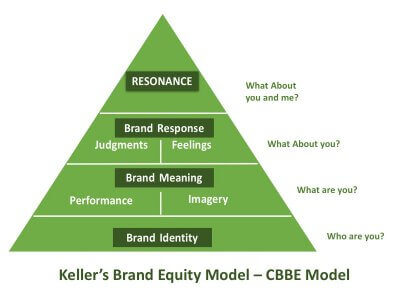The best-known CBBE model is the Keller Model, devised by Professor of Marketing Kevin Lane Keller and published in his mighty Strategic Brand Management.
The Keller model is a pyramid shape and shows businesses how to build from a strong foundation of brand identity upwards towards the holy grail of brand equity ‘resonance’: where customers are in a sufficiently positive relationship with a brand to be advocates for it.

The way up to the resonance level affords a brand opportunities to recognise and capitalise on its customers’ loyalties and attitudes – both positive and negative. By dividing CBBE into Keller’s four levels, marketers can understand what their customers want and need before they’ve even bought the product, or maybe even before they know they want it.
The iPad is a stunning example of this CBBE: from the robust foundation of Apple’s brand identity, the iPad was developed to look great, be easy to use, do everything its customers wanted, and more. Customers loved it and any glitches that attracted negative responses were quickly patched. Before long, iPad users were extolling its virtues and their loyalty, and the iPad is now ubiquitous in stores, health centres, schools, offices and homes. It’s a classic example of something we didn’t know we needed or wanted until we saw one. Now we can’t do without it.
Get started with our free brand awareness survey template
Access nowThe 4 levels of Keller’s CBBE model
Level 1: Brand identity (who are you?)
This is how customers look at your brand and distinguish it from others. It explores the words and images buyers associate with when they hear a particular brand name. It’s the most important level and must be strong to support the rest of the pyramid above it. Brand identity quantifies the breadth and depth of customer awareness of a brand. Start to build it when customers are unaware of your products and values, attracting them with ad campaigns and targeted marketing.
Level 2: Brand meaning (what are you?)
Once customers become aware of your brand, they’ll want to know more about your product. They’ll question its features, looks and style, reliability, durability, customer experience and value for money, to find its brand meaning. For the purposes of brand reputation, Level 2 is split into two categories:
- Brand performance: This covers product functionality, reliability, durability, and price as well as customer service and satisfaction. It’s ‘it does what it says on the tin’ territory and when it performs well, customer opinion will be positive.
- Brand imagery: different, but equally important, imagery meets the customers’ social and psychological needs. What does the brand appear to be to customers? Volvo appears Scandi-chic, family-orientated, safe and eco-responsible; Cushelle soft, homely and cozy. This messaging can come out in targeted marketing and word of mouth.
Level 3: Brand response (what are the feelings for the brand?)
On this level of Keller’s model, judgment and feelings can be hard to separate and are intensely personal for each individual customer. One customer may judge the brand irrelevant to them, whereas another will find it completely relevant. Another may make their own value comparison against another product, harshly or fairly. And add to the mix actual interaction and perceived reputation and you can see how hard it can be to quantify how customers feel about a brand and how much they trust it. Companies need to respond to judgments and build positive feelings about the brand once they know what they are.
Level 4: Brand resonance (a strong relationship)
The apex of Keller’s CBBE model is resonance: when a customer is loyal to a brand, considers it superior, will buy no other and advocates its merits to others. Many things resonate with customers: lifetime experience, customer service, products and value. A good measure for resonance is the Net Promoter Score that asks one simple question: ‘How likely is it that you would recommend [Product X] to a friend or colleague?”.
Keller’s model is deceptively beautiful in its simplicity; building customer-based brand equity is, in reality, a long and hard road. When you start at the bottom with a great brand identity, then get customers to know your brand and your business gradually, you’ll create a brand that people will like, trust and which will ultimately be successful.
Get started with our free brand awareness survey template